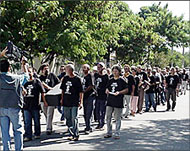Brazil’s asbestos victims gasp for justice
Joao Baptista Momi was a loyal factory worker for 32 years.

“I was proud of the company, they paid a good salary,” he says of his bosses at Eternit.
But the company was using asbestos in its products. Now aged 71, Joao is debilitated by asbestosis, the disease caused by toxic fibres blocking his lungs.
”The company never warned me that the powder was harmful; I did not wear any masks. I was deceived,” he says.
Joao is one of Brazil’s estimated 2500 asbestos victims – and the numbers are set to grow. The country is home to one of the largest asbestos mines in the world.
French and Swiss-based companies continue wide-scale mining of chysotile, or ‘white’ asbestos in Brazil, despite a prohibition on its use in their own countries. Its use in new buildings was also banned in the UK in 1999.
Unlike the world’s leading exporter, Canada, most of Brazil’s asbestos remains in the country, and can be found in 60% of houses despite being a grade one carcinogen with no safe limit of exposure.
Joao’s fight for compensation was taken up by factory inspector Fernanda Giannasi, 45, who has gained international fame by waging a fierce campaign to ban the toxic substance.
Harassment
Giannasi says she has been investigated by the Brazilian FBI, blackmailed by her government bosses, received death threats and suffered court writs by international asbestos companies. In 2001, she was nominated Woman of the Year in Brazil.
 |
|
Fernanda Giannasi has brought the issue to prominence |
“Until 1993, I believed that the fibre could be used safely. Then I realised it was not feasible, and began to widen this discussion in society for the replacement of asbestos. Today I am certain that it is a just and necessary fight,” Giannasi told Aljazeera.net.
Asbestos exposure can cause respiratory diseases, lung cancer and asbestosis.
A survey in August this year by ABREA, the national association of asbestos victims, involving 1022 former cement industry workers at the Eternit plant in Osasco, S?o Paulo, found 24 had died from asbestos-related diseases. Another 25 fatalities were not officially recognised as asbestos-related diseases.
It also found 223 cases of respiratory disorders, 192 cases of pleura plaques (a thickening of the membrane covering the lungs), 109 cases of asbestosis and two surviving lung cancer victims.
Rising death rate
Asbestosis can take 30 to 40 years to appear and kill.
Giannasi thinks that from 2005, the greatest number of life-threatening cases will begin to appear as a result of the wide-scale mining, which began under the military dictatorship in the 1970s.
“The big boom was in the 70s when there was large-scale construction of cheap housing made from asbestos,” says Giannasi.
“It’s insane, especially as the material is unsuitable for Brazil’s hot and humid climate. The fibres begin to disintegrate after five years,” she says.
Only two of Brazil’s 28 states, Rio de Janeiro and Rio Grande do Sul, have banned the trade in asbestos. Rio’s law goes further than banning – it covers compensation to victims.
Rio de Janeiro State Deputy Carlos Minc introduced the bill as a direct result of Giannasi’s tireless work.
“She drew our attention to the asbestos problem just as (legendary campaigner) Chico Mendes did regarding the rubber-tapper issue,” he says.
Funeral meetings
Encouraged by Giannasi, the pioneers in the fight against asbestos exposure were former workers of the now-defunct Eternit company (owned by Saint Gobain) in Osasco, Sao Paulo.
In 1995, they created the national association, ABREA. Many of the victims were first contacted at the funerals of others.
 |
|
Protestors target multinationals who exploit Brazil’s lax laws |
The organisation carries out medical tests on victims and has over 500 cases in the Brazilian courts, seeking compensation for its members who have refused settlements.
Precedent across the Atlantic suggests that any victory will be hard-won.
It took five years of legal battles to secure a landmark $30 million settlement between the Cape asbestos mines group and South African communities, and a further year for the firm to pay out.
“Central to the Cape case was that multinational companies undertaking hazardous operations overseas should be held accountable for resultant injuries,” says Cecil Skeffers of the South African-based NGO Concerned People Against Asbestos.
The Cape claimants’ solicitor, Richard Spoor, is now chasing other mining companies, including Eternit, for their operations in South Africa. The uncompensated victims of the company in Brazil will be closely watching his progress.
The Cape workers brought a private lawsuit, which was heard in UK courts. For Brazilians to do the same in France and Switzerland would require financial aid and the will of victims to hold out.
Low compensation
“In Brazil, the compensation offered by the companies is ridiculously low, typically $3000. But, some victims accept it because of their desperate need for money, the need to address their disability and their distrust of the judicial system.
“It wasn’t until a number of companies had shut down that the workers came to us. All of them were very ill. Nobody had ever told them that asbestos was dangerous. If it was brought up at all, they were told ‘it is safe because it is white,” says Giannasi.
|
“I have worked under every administration from the military dictatorship until today, but still nothing changes. I am anguished by the political situation in this country” Fernanda Giannasi, |
French multinational Saint Gobain employs 173,000 workers in 47 countries and has been operating in Brazil since 1937.
Around 300,000 Brazilians have been exposed to asbestos, two-thirds in workplaces according to Dr Rene Mendes, president of the Brazilian Association of Occupational Medicine.
“The asbestos problem requires broad action, social mobilisation and state intervention,” says Dr Mendes.
More than 3000 products contain asbestos from roofing and insulation to children’s toys and wax crayons.
To ban asbestos would bring huge unemployment to states like Goias, where 200,000 people are involved in the production chain. Exports are worth over $30 million to Brazil every year.
Two lines
However, campaigners insist that cheap alternatives are readily available and even used – the car industry in Brazil continues to use asbestos for the domestic market but not for export.
“In the same plant you can see two lines – one with asbestos and the other asbestos-free, depending on which trademark they are going to put on the products,” says Giannasi.
As yet there are no firm plans by the ruling Worker’s Party government to ban asbestos countrywide despite innumerable bills on the issue.
“To me the most serious problem in Latin America is the social invisibility of asbestos-related diseases and the lack of support to asbestos victims groups by the unions and politicians. The unions are worried about unemployment and the politicians are quiet because of their political and financial interests,” says Giannasi.
“I have worked under every administration from the military dictatorship until today, but still nothing changes. I am anguished by the political situation in this country.”